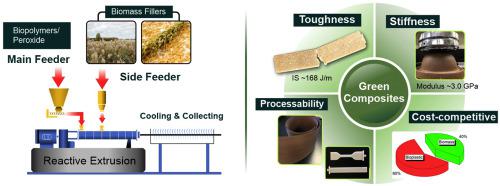当前位置:
X-MOL 学术
›
Compos. Sci. Technol.
›
论文详情
Our official English website, www.x-mol.net, welcomes your
feedback! (Note: you will need to create a separate account there.)
Sustainable green composites from biodegradable plastics blend and natural fibre with balanced performance: Synergy of nano-structured blend and reactive extrusion
Composites Science and Technology ( IF 8.3 ) Pub Date : 2020-11-01 , DOI: 10.1016/j.compscitech.2020.108369 Feng Wu , Manjusri Misra , Amar K. Mohanty
Composites Science and Technology ( IF 8.3 ) Pub Date : 2020-11-01 , DOI: 10.1016/j.compscitech.2020.108369 Feng Wu , Manjusri Misra , Amar K. Mohanty

|
Abstract We herein report a unique scientific strategy in engineering green composites with excellent balanced performance of stiffness, toughness and heat deflection temperature (HDT). To achieve such target, a high melt strength bioplastic blend of poly (butylene succinate), PBS and poly (butylene-adipate-co-terephthalate), PBAT with super toughness could take-up stiff natural fibres like inexpensive purpose grown Miscanthus fibre and Oat hull (a co-product from food industry) in the green composite structure through reactive extrusion. The novelty of this work is to allow the free radical reaction to occur within polymer matrix and between the blend and natural fibres by introducing biomass from a side feeder, aiming to achieve matrix toughening and polymer/fibre interface enhancement simultaneously. Tensile modulus of the bio-blends was improved by maximum 650% with the reinforcement of 40 wt% agricultural by-products. For equal amounts of 40% biomass fibres, the Miscanthus fibre is more suitable to strengthen the biopolymers, in terms of higher modulus (3.0 GPa), higher HDT (110 °C) and lower water absorption (3.4%); however, the oat hull composites show much higher impact strength of 83 J/m. A systematical structure-properties relationship study indicates that higher aspect ratio, higher cellulose contents and stronger interfacial actions account for the higher stiffness and HDT of the Miscanthus fibre composites compared to the oat hull-filled counterparts. This abundant biomass has potential to fabricate sustainable composites to substitute certain fossil fuel-based plastics in terms of mechanical and thermal properties, as well as cost and energy-saving via using the industrial friendly technology as proposed here.
中文翻译:

具有平衡性能的可生物降解塑料混合物和天然纤维的可持续绿色复合材料:纳米结构混合物和反应挤出的协同作用
摘要 我们在此报告了一种独特的科学策略,在工程绿色复合材料方面具有优异的刚度、韧性和热变形温度 (HDT) 的平衡性能。为了实现这一目标,聚(丁二酸丁二醇酯)、PBS 和聚(己二酸丁二醇酯-对苯二甲酸丁二醇酯)的高熔体强度生物塑料混合物,具有超强韧性的 PBAT 可以吸收坚硬的天然纤维,如廉价的专用生长芒草纤维和燕麦通过反应挤压将船体(食品工业的副产品)制成绿色复合结构。这项工作的新颖之处在于通过从侧进料器引入生物质,允许自由基反应发生在聚合物基质内以及共混物和天然纤维之间,旨在同时实现基质增韧和聚合物/纤维界面增强。生物混合物的拉伸模量提高了 650%,增强了 40% 的农业副产品。对于等量的40%生物质纤维,芒草纤维更适合增强生物聚合物,具有更高的模量(3.0 GPa)、更高的HDT(110°C)和更低的吸水率(3.4%);然而,燕麦壳复合材料显示出更高的冲击强度,为 83 J/m。一项系统的结构-性能关系研究表明,与燕麦壳填充的对应物相比,芒草纤维复合材料具有更高的纵横比、更高的纤维素含量和更强的界面作用,因此具有更高的刚度和 HDT。这种丰富的生物质具有制造可持续复合材料的潜力,以在机械和热性能方面替代某些基于化石燃料的塑料,
更新日期:2020-11-01
中文翻译:

具有平衡性能的可生物降解塑料混合物和天然纤维的可持续绿色复合材料:纳米结构混合物和反应挤出的协同作用
摘要 我们在此报告了一种独特的科学策略,在工程绿色复合材料方面具有优异的刚度、韧性和热变形温度 (HDT) 的平衡性能。为了实现这一目标,聚(丁二酸丁二醇酯)、PBS 和聚(己二酸丁二醇酯-对苯二甲酸丁二醇酯)的高熔体强度生物塑料混合物,具有超强韧性的 PBAT 可以吸收坚硬的天然纤维,如廉价的专用生长芒草纤维和燕麦通过反应挤压将船体(食品工业的副产品)制成绿色复合结构。这项工作的新颖之处在于通过从侧进料器引入生物质,允许自由基反应发生在聚合物基质内以及共混物和天然纤维之间,旨在同时实现基质增韧和聚合物/纤维界面增强。生物混合物的拉伸模量提高了 650%,增强了 40% 的农业副产品。对于等量的40%生物质纤维,芒草纤维更适合增强生物聚合物,具有更高的模量(3.0 GPa)、更高的HDT(110°C)和更低的吸水率(3.4%);然而,燕麦壳复合材料显示出更高的冲击强度,为 83 J/m。一项系统的结构-性能关系研究表明,与燕麦壳填充的对应物相比,芒草纤维复合材料具有更高的纵横比、更高的纤维素含量和更强的界面作用,因此具有更高的刚度和 HDT。这种丰富的生物质具有制造可持续复合材料的潜力,以在机械和热性能方面替代某些基于化石燃料的塑料,











































 京公网安备 11010802027423号
京公网安备 11010802027423号